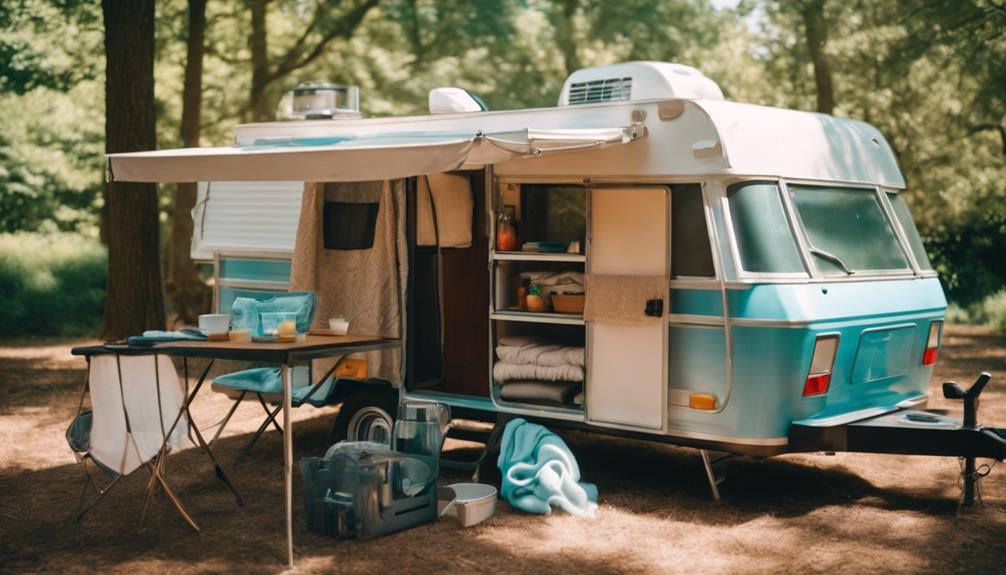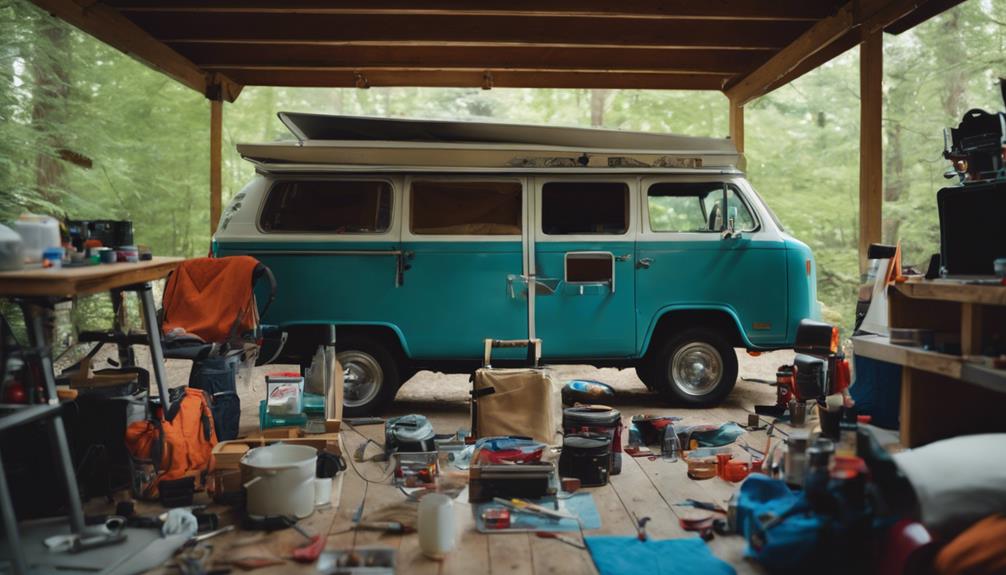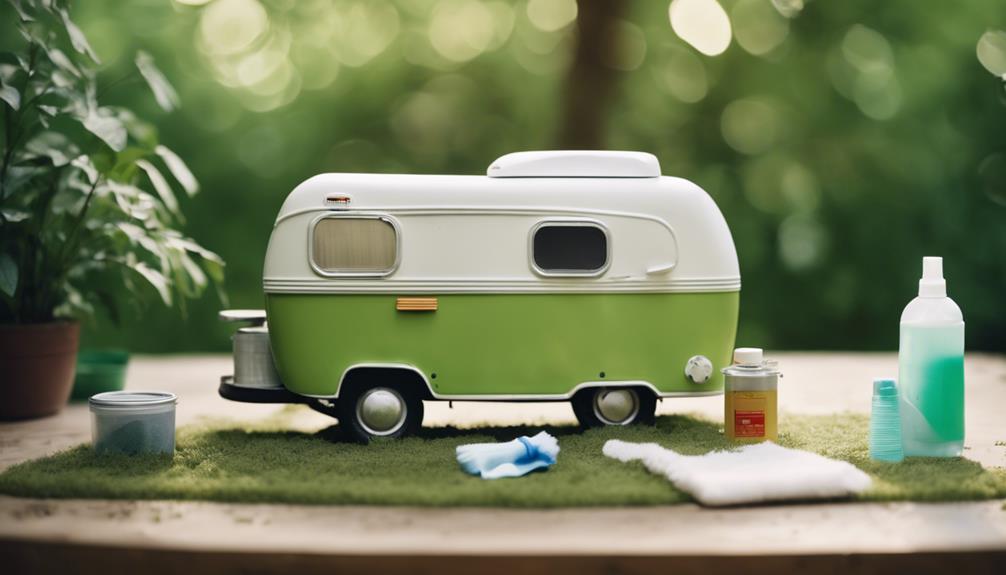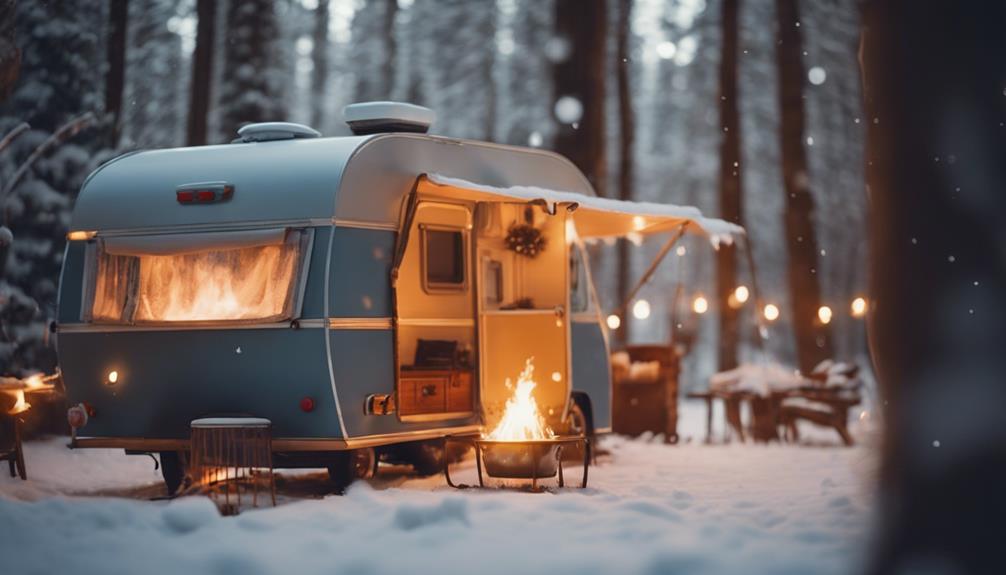To drain your pop-up camper's water tank, start by locating the drain valve under the dinette seat. You may need to remove cushions or covers for better access. Once you've found the valve, open it manually to allow the water to flow out. Make sure your camper is level for smooth drainage and place a bucket or hose under the valve to catch the water. It's crucial to close the valve securely after draining to prevent leaks. Regular maintenance like this keeps your water supply clean and helps avoid damage during winter storage. There's more to explore to keep your camper in top shape.
Key Takeaways
- Locate the water tank and drain valve under the dinette seat, using a flashlight for visibility.
- Open the drain valve manually and ensure the camper is level for effective drainage.
- Use a bucket or hose to collect water, and remove the drain plug carefully to avoid splashing.
- Regularly check and clean the drain valve to maintain optimal performance and prevent clogs.
Locating the Water Tank
To locate the water tank in your pop-up camper, check under the dinette seat, as that's where it's usually hidden. You'll typically find the fresh water tank tucked away, making it crucial to access from inside the trailer. Once you've lifted the seat cushion or disassembled any covers, look for the tank itself.
The drain valve is often located at the bottom of the water tank, and you might need to inspect through a small hole in the floor. In some camper models, the drain mechanism resembles a recessed plug, similar to what you'd see in an oil pan, while others may feature a petcock for easier drainage.
To help identify the drainage points effectively, check for clear hoses or visible drain lines connected to the tank. This way, you can ascertain you're ready to drain the water when needed. Remember, there's usually no external access to the tank, so locating it inside is your best bet.
Once you find the water tank, you can proceed with your maintenance tasks, ensuring your camper is ready for your next adventure.
Understanding Drain Mechanisms
Understanding the different drain mechanisms in your pop-up camper is essential for efficient water management and maintenance. Knowing how your fresh water tank is set up will make draining it much simpler. Here are some key points to take into account:
- Location: The fresh water tank is usually under the dinette seat, where the drain valve is often accessible from within the camper.
- Types of Valves: Some campers have a recessed drain plug like an oil pan, while others feature a manual valve on the tank's front or side.
- Inspection Need: You'll need to inspect the tank closely to find the drain mechanism, as there's typically no external access point.
- Accessibility: Sometimes, you might have to crawl under the trailer to locate the drain valve, which can be tricky. Using a flashlight can help you see better.
To make tank maintenance easier in the future, think about modifications like adding external drain hoses with valves. This will save you time and effort during the draining process, ensuring your camper stays in top shape.
Draining Process Steps
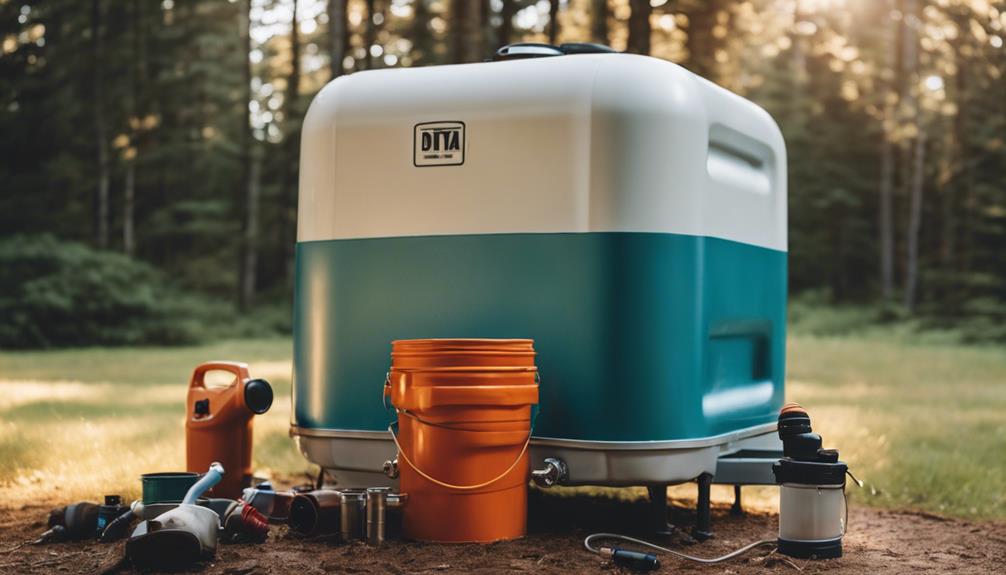
To drain your pop-up camper's water tank, start by locating the drain valve, typically found under the dinette seat.
You might need to remove some seating covers for better access, so keep a flashlight handy.
Once you find the valve, open it manually to let the water flow out completely.
Locate Drain Valve
Inspecting under the dinette seat often reveals the drain valve for the fresh water tank in your pop-up camper. To locate it effectively, follow these steps:
- Check the Seat Area: Look beneath the dinette seat, as this is the most common location for the drain valve.
- Look for a Recessed Plug: Some models have a recessed plug or petcock at the bottom of the tank, possibly visible through a small hole in the floor.
- Inspect for Disassembly: If the valve isn't immediately visible, you may need to remove a panel or cushion for better access.
- Manual Operation: Familiarize yourself with how to operate the drain valve, as it often requires manual opening and closing.
Once you find the drain valve, you're one step closer to completing the draining process.
Remember to verify the valve is securely closed after draining to prevent leaks.
Regularly locating and utilizing the drain valve is essential for maintaining your water tank and verifying clean water during your camping trips.
Manual Drain Techniques
Now that you've located the drain valve, you can follow these manual drain techniques to effectively empty the water tank in your pop-up camper.
First, verify that your camper is parked on level ground. This helps the water flow out smoothly. Next, place a bucket or hose under the drain valve to catch the water. If you have a recessed plug or petcock, remove it carefully to avoid splashing.
Once the drain valve is opened, you can use a manual pump to help drain the tank. This is especially useful if your holding tanks are large or if gravity doesn't do the job. Pumping will speed up the process and verify you empty the tank completely.
After you've drained the tank, make certain to securely close the drain valve. This prevents any leaks and keeps your camper clean.
Regularly emptying your water tank before travel not only reduces weight but also helps prevent stagnation and unwanted odors. For future convenience, consider modifying the plumbing by adding external drain hoses and valves for easier access.
Importance of Regular Maintenance
Regular maintenance of your pop-up camper's water tank is vital for guaranteeing a clean and safe water supply during your trips. Neglecting this can lead to issues that compromise your camping experience.
Here are four key reasons why you should prioritize regular maintenance:
- Prevent Bacterial Growth: Regularly draining the tank prevents stagnation, which can lead to contamination.
- Enhance Towing Efficiency: Keeping the tank empty when not in use reduces overall weight, improving fuel economy.
- Winter Protection: Draining the tank is essential during winterization to protect plumbing from freeze damage.
- Optimal Functioning: Consistent checks and maintenance guarantee your water system functions properly, providing clean water.
Seasonal Maintenance Tips
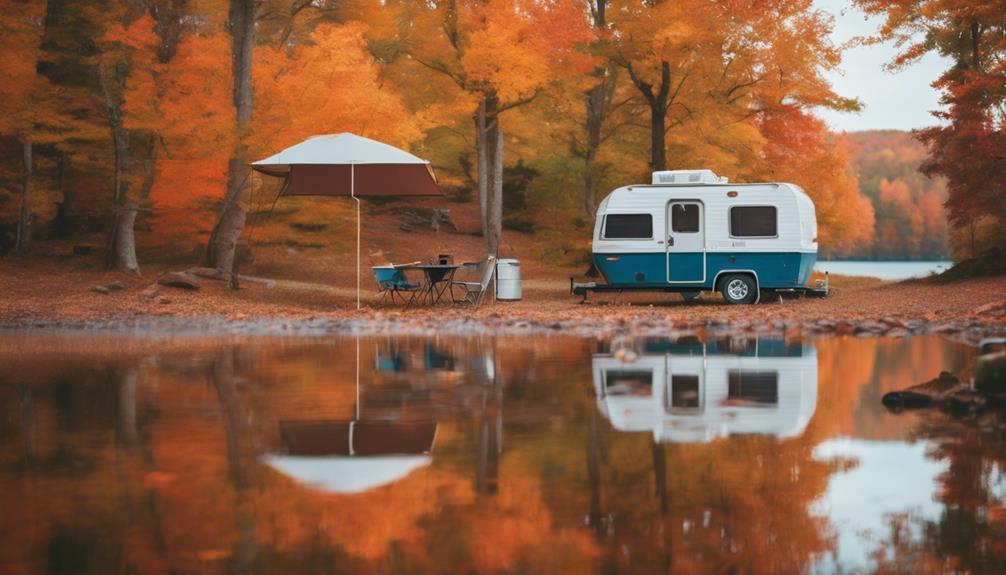
Seasonal maintenance of your pop-up camper's water tank guarantees it stays in top shape and ready for your adventures.
Start by regularly emptying the fresh water tank before you leave the campsite. This reduces weight and prevents stagnation, assuring both hygiene and peak system functionality. During winterization, make sure to drain the tank completely to avoid freezing and potential damage. Don't forget to seal the drain valve properly afterward.
Inspect the water system periodically, focusing on the drain valve to assure it opens and closes without issues. This proactive maintenance helps you avoid complications during your trips.
Additionally, clean the fresh water tank annually using a bleach solution. This step eliminates bacteria and contaminants, assuring safe drinking water for your future outings.
Familiarize yourself with your specific pop-up camper model's drainage setup, as configurations can vary widely. If needed, consider modifications that improve access to the drain valve.
Troubleshooting Common Issues
When you're trying to drain your pop-up camper's water tank, you might run into a few common issues.
Locating the drain valve can be tricky, especially if you're not familiar with your camper's layout, and manual pumps can complicate things further.
Let's explore effective techniques to tackle these challenges and guarantee a smooth draining process.
Locating Drain Valve
Finding the drain valve in your pop-up camper can be tricky, so it's important to inspect the area beneath the dinette seat for easy access. Here are some tips to help you locate the drain valve efficiently:
- Check the Tank Area: Look under the dinette seat where the fresh water tank is typically housed.
- Use a Flashlight: Visibility can be poor, so a flashlight will help you see into dark corners.
- Look for Recessed Plugs: Some models have a recessed plug or petcock, making drainage easier without disassembly.
- Consider External Modifications: If you frequently face issues, adding an external drain hose can simplify the process and improve accessibility to the drain valve.
If you can't find the valve internally, there might be a small hole in the camper floor for drainage. Be prepared to crawl under the trailer if necessary.
Proper cleaning and maintenance of the drain valve will guarantee it functions correctly, preventing future frustrations. Always remember, a little effort in locating the drain valve can make your draining process a breeze!
Manual Pump Challenges
Manual pump issues can be frustrating, especially if you're not familiar with the common challenges that can arise during operation. One of the first things to check is the fresh water tank; if it's low or empty, the manual pump won't be able to draw water effectively. Verify that the tank is filled to the appropriate level before attempting to pump water.
If the manual pump isn't delivering water, inspect the water lines for any blockages or kinks that might be hindering flow. Air can also get trapped in the lines, which can stop the water from flowing smoothly. Regular maintenance is key—make sure to clean the pump screen and check for any leaks that could impede operation.
Additionally, consult your owner's manual for specific troubleshooting steps tailored to your pump model. Different models may have unique features that require different approaches.
Effective Drainage Techniques
To effectively drain your pop-up camper's water tank, start by locating the drain valve, which is often hidden beneath the dinette seat. It's essential to familiarize yourself with its mechanism so you can efficiently manage your fresh water system.
Here are some effective drainage techniques to take into account:
- Use a flashlight: If you're having trouble finding the drain valve, illuminating the area can greatly improve visibility.
- Manual operation: Most drain valves require manual operation, so make sure you understand how to open and close it properly.
- Explore modifications: Adding an external drain hose with a valve can simplify the drainage process, making it more accessible and user-friendly.
- Regular maintenance: Empty your tank regularly, especially before winterization, to prevent stagnation and keep your water system clean.
Implementing these techniques can help you troubleshoot common issues related to draining your water tank.
Community Experiences and Insights
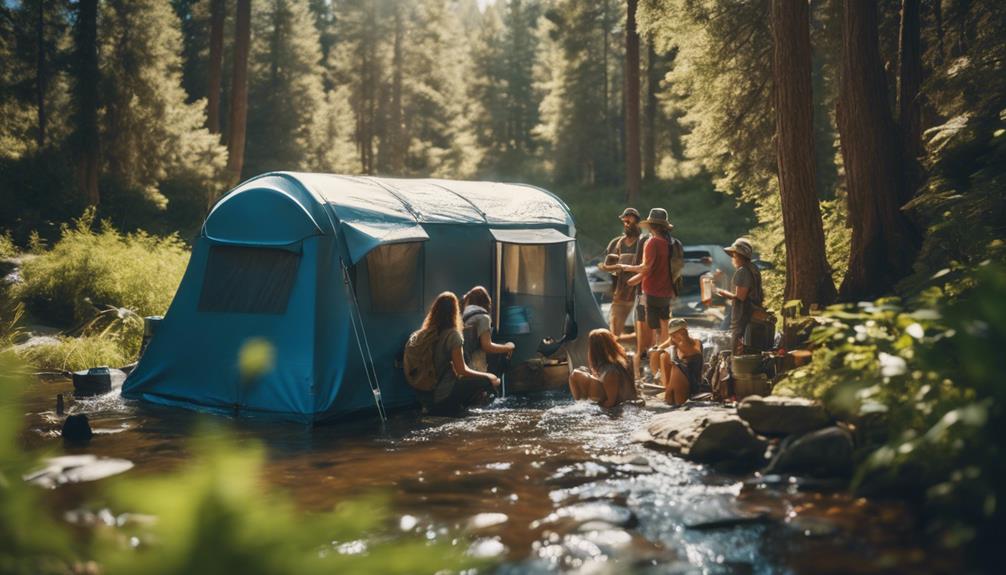
Many pop-up camper owners have shared valuable tips and tricks for draining water tanks, making the process easier for newcomers. One common piece of advice is to inspect the area under the dinette seat, where you'll often find the drain valve. Some users have also mentioned that certain models have a recessed plug, similar to an oil pan drain, which can help streamline the draining process.
Community discussions highlight the importance of regular maintenance. Draining your water tank before travel not only reduces weight but also prevents stagnation, especially during winterization. Many owners recommend using flashlights when searching for those elusive drain valves, as thorough inspections can save you from frustration.
The insights shared by fellow campers emphasize how valuable community support can be. Engaging with others on forums like PopUpPortal allows you to learn from their experiences, troubleshoot issues, and improve your maintenance practices. By tapping into this wealth of knowledge, you'll feel more confident in managing your pop-up camper's water tank and ensuring it stays in great shape for your adventures.
Cleaning and Sanitizing the Tank
Cleaning and sanitizing your pop-up camper's water tank is just as important as knowing how to drain it, guaranteeing you maintain a safe and healthy water supply for your adventures. Here are four essential steps to follow for effective cleaning:
- Prepare the Cleaning Solution: Mix half a cup of fresh bleach with water in your 30-gallon fresh water tank.
- Distribute the Solution: Slosh the chlorinated water around the tank to guarantee thorough distribution.
- Sanitize the Tank: Allow the bleach solution to sit for at least three hours to effectively sanitize the tank.
- Flush the System: After sanitizing, flush the system thoroughly until the bleach smell dissipates, guaranteeing no residual bleach remains in your water lines.
Regular annual cleaning of your fresh water tank helps prevent the buildup of bacteria and contaminants.
Always remember to use potable water hoses when filling the tank to maintain cleanliness.
Preparing for Winterization

Before the cold sets in, it's vital to prepare your pop-up camper for winterization to protect its water system from freezing damage.
Start by ensuring that the fresh water tank is completely drained. This prevents freezing and potential damage during the winter months. Locate the drain valve, typically found under the dinette seat, and operate it manually to facilitate the complete drainage of the tank.
If you want quicker drainage, consider using a petcock. While you're at it, check for any plumbing modifications that could simplify the winterization process.
It's also a good idea to flush and sanitize the fresh water tank before you store your camper. This helps eliminate bacteria and contaminants, ensuring a clean start for your next camping season.
Once you've drained the tank, make sure to securely close the drain valve. This step is vital to prevent any residual water from entering the tank, which could cause stagnation or unpleasant odors.
Taking these steps will help you maintain your pop-up camper and protect its water system through the harsh winter months.
Frequently Asked Questions
How to Drain a Pop-Up Camper Water Tank?
To drain your pop-up camper's water tank, locate the drain valve under the dinette seat. Open it manually, then verify you close it securely after draining to prevent leaks and maintain system integrity.
How Do You Empty an RV Water Holding Tank?
Ever wonder how to keep your RV clean? To empty the holding tank, locate the drain valve, connect the sewer hose securely, drain the black water first, then the grey, and clean afterward to maintain efficiency.
Should I Drain My RV Water Tank Between Trips?
Yes, you should drain your RV water tank between trips. It prevents stagnation and bacteria growth, reduces weight for better towing, and makes winterization easier. Just remember to securely close the drain valve afterward.
How to Clean a Popup Camper Water Tank?
Imagine you're prepping for a weekend getaway. To clean your pop-up camper's water tank, mix half a cup of bleach with a full tank of water, let it sit, then flush thoroughly for a fresh supply.
Can I Drain the Water Tank Before Recycling My Pop-Up Camper?
Yes, you can drain the water tank before recycling your pop-up camper. It is important to properly prepare your recycling popup camper ecofriendly disposal by emptying the water tank to prevent any potential leaks or spills during the recycling process.
Conclusion
Draining your pop-up camper's water tank isn't just about preventing leaks; it's a vital step in keeping your camper in top shape.
Have you ever imagined the thrill of hitting the road, knowing your camper's water system is clean and functioning perfectly?
By following these maintenance tips and staying proactive, you can guarantee countless adventures ahead.
So, take the time to care for your tank—it'll pay off in memorable experiences under the stars!


